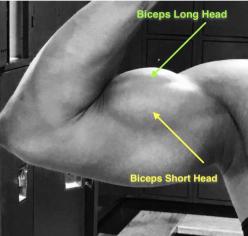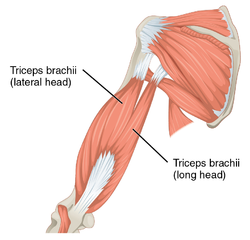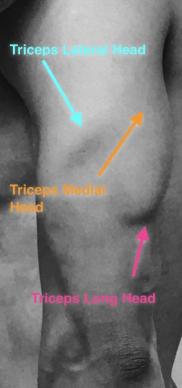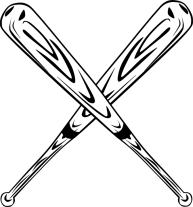The end of summer may mean it’s time to cover up the “guns” in your sleeves but it also means it’s about time to start building them back up.
Do you want bigger, stronger, more defined arms? Here’s how.
When you think of big arms, you probably think of biceps. As you can see in the illustration below, the triceps are also going to make a good part of the the arm mass. In fact, you want to train them in about the same volume.

Simply put, your biceps’ job is to contract to bend your elbow to move your forearm towards the upper arm. Your triceps flex to extend the elbow to move your forearm away from the upper arm.
Anatomy
The bi- prefix indicates there are two heads to the muscle: a long head and a short head. Picture your arm hanging straight down at your side. Your biceps will be facing forward. The short head of your biceps will be closer to your torso. The long head will be farther from your torso.


You can probably guess what the tri- prefix means for the back of your arm. That’s it, there are three heads: the lateral, long, and medial. It’s easier to see in an image. [photo] Together they form a shape resembling a horseshoe. Look at the body from the back with the arms hanging straight down. The long head starts around the back of the shoulder/armpit area. The lateral head (sometimes called the short head) is on the outside, farther from the torso. The medial head is on the inside, but closer to the elbow than the others.


Biceps Training
The most common way you’ll see people training biceps is through curls. Does it work? Yes. But the best way to get your muscles to grow is to get stronger by lifting more weight over time. Biceps curls are an isolation exercise, which means they focus solely on one muscle group. That’s the good part. You’ll see people doing all kinds of variations of curls: standing, sitting, concentration, alternating, hammer, spider, incline, decline, reverse-grip. Of course there are all kinds of weight machines as well. All that’s cool.
However, the downside of isolation exercises is that you really can’t use that much weight when compared to compound exercise. Pull-ups and chin-ups are compound movements that train the back and biceps. Rows are great also. You could build an impressive set of biceps just by focusing on these alone. This is because you’ll be lifting your body, which obviously is a lot heavier than the dumbbells you’d use for curls. Once you get to the point where you can tack on extra iron for your chin-ups, you’ll be moving some impressive weights. And that is the key to getting strong and building muscle.
The main emphasis should be on getting stronger at the compound movements. Try doing 3-5 sets of 5-10 repetitions, with 1-3 minutes of rest once or twice a week. I know that’s a big range of reps. You’ll find some people will respond better to sets with closer to 5 reps while others will need closer to 10. The main key will be focusing on getting stronger.
A great way to make this happen is to gradually increase the number of reps or sets. If you build your way from 3 sets of 5 reps to 3 sets of 7 reps, you’ve gotten stronger. Add on 5-10 lbs. and go back to 3 sets of 5 reps. Build your way up and repeat the process.
(It’s a given that you’re using good form, right? Right? )
This is going to improve your gains far more efficiently than doing 8 different versions of curls. I’m not against curls, or isolation movements in general. You get the most efficient gains from compound movements. Compounds are like your main dishes. Isolations are the side orders. When you do your isolation lifts, you want to ensure you’re using the muscles and not momentum to move the weight. I recommend 2-3 sets of 5-12 repetitions.
If you want to deep dive into your isolation lifts, the short head of the biceps is emphasized when the arm is in front of the body in exercises like preacher curls and concentration curls. To focus more on the long head, have your upper arm slightly behind your body and try incline dumbbell curls and hammer curls.
Triceps Training
When working on arms, we tend to overemphasize training the biceps, often to the neglect of the triceps. The truth is the triceps are just as important, if not more, when it comes to growing impressive guns.
Similar to the biceps, you’ll often see people in the gym doing a bunch of isolation movements. There are extensions, cable extensions, overhead extensions, (the ominous-sounding) skull crushers, weight machines and on and on. Again, they do work but they’re not going to be the most efficient method for you.
Compound lifts are your friends! Pressing exercises like bench press (particularly close-grip bench), overhead press, dips, even pushups are great ways to develop your triceps. You don’t have to do every exercise in order to make gains. Pick a couple compound exercises and work on building your strength at those. Use a similar sets and reps scheme as for the upper body pulls.
Toss in some isolation work as a complement afterwards. Again, 2-3 sets of 5-12 once or twice is plenty. You can put emphasis on the lateral head with triceps exercises where your arms are by your sides and you’re using an overhand (palms down) grip (e.g. dips). To focus on growing the medial head, your arms will be at your sides but you’ll use an underhand grip (e.g. reverse-grip press downs). Build the lateral head by choosing exercises where your arms are overhead (e.g. skull crushers or overhead extensions).
Rest and Recovery
In order to get the most out of your time in the gym, you want to do the right things outside of the gym. That means getting plenty of rest. You work the muscles in the gym but they recover and grow only if you allow sufficient time between workouts. Eat enough food, particularly protein, to support your gains, but not so much that you get fluffy.
Now you’re all set to make some great arm gains! The only thing left to do is put in the work.
Hope this helps. Any questions or comments, let me know.





 tivation is what’s going to drive you to go after your goals over the long term. But every once in a while, we all need a little nitro to give us a temporary turbo boost.
tivation is what’s going to drive you to go after your goals over the long term. But every once in a while, we all need a little nitro to give us a temporary turbo boost.






